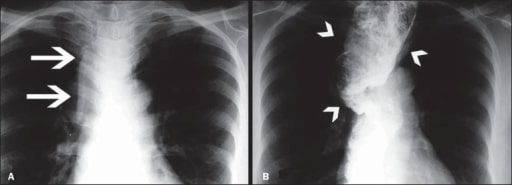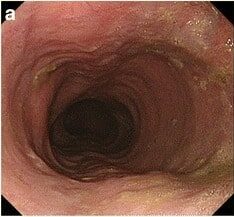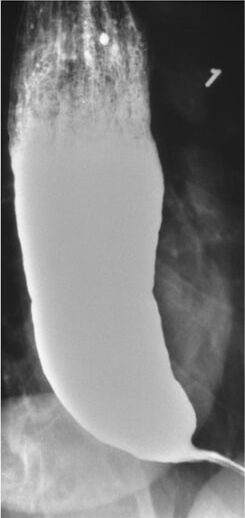Achalasia is an esophageal motility disorder that is due to degeneration of the myenteric plexus; it results in failure of the lower esophageal sphincter to relax and a lack of normal esophageal peristalsis. Patients typically present with dysphagia to solids and liquids, along with regurgitation. Diagnosis is established by high-resolution manometry. Upper endoscopy is performed to rule out malignancy as a cause. Barium swallow study helps evaluate the esophageal morphology. Management options include pneumatic balloon dilation, surgical myotomy, and botulinum toxin injection. Choice of treatment is dependent on the type of achalasia and surgical risk. Medications are available for those for whom initial intervention fails but provide the least benefit.
Last updated: May 26, 2025

Image of megaesophagus (loss of esophageal motility and diffuse esophageal dilation)
A: Posteroanterior (PA) chest X-ray showing widening of the superior mediastinum (arrows)
B: Barium swallow study demonstrating a dilated and tortuous esophagus (arrowheads)
Clinical Guidelines
Diagnostic testing for achalasia Achalasia Achalasia is a primary esophageal motility disorder that develops from the degeneration of the myenteric plexus. This condition results in impaired lower esophageal sphincter relaxation and absence of normal esophageal peristalsis. Patients typically present with dysphagia to solids and liquids along with regurgitation. Achalasia is indicated in patients Patients Individuals participating in the health care system for the purpose of receiving therapeutic, diagnostic, or preventive procedures. Clinician–Patient Relationship with:

All types exhibit impaired EGJ relaxation with swallowing.
Type I: upper esophageal sphincter relaxes, but there is 100% failure of contractions and no esophageal pressurization (absent peristalsis)
Type II: panesophageal pressurization in at least 20% of swallows
Type III: preserved fragments of distal peristalsis or premature spastic contractions for at least 20% of swallows

Esophagogastroduodenoscopy showcasing a dilated esophagus with food residue in a patient presenting with achalasia
Image: “Gastrointestinal endoscopy findings” by US National Library of Medicine. License: CC BY 4.0
Achalasia seen on a barium swallow study: Narrowing is seen at the distal esophagus (“bird’s beak”) due to inadequate relaxation of the lower esophageal sphincter.
Image: “Barium swallow” by Department of Internal Medicine, Nashville, TN, USA. License: CC BY 4.0Management guidelines may vary depending on practice location. The following information is based on US and UK guidelines and literature.
The loss of ganglion cells Ganglion Cells The Visual Pathway and Related Disorders is irreversible in patients Patients Individuals participating in the health care system for the purpose of receiving therapeutic, diagnostic, or preventive procedures. Clinician–Patient Relationship with achalasia Achalasia Achalasia is a primary esophageal motility disorder that develops from the degeneration of the myenteric plexus. This condition results in impaired lower esophageal sphincter relaxation and absence of normal esophageal peristalsis. Patients typically present with dysphagia to solids and liquids along with regurgitation. Achalasia; treatment is aimed at decreasing lower esophageal sphincter Lower Esophageal Sphincter Esophagus: Anatomy hypertonicity Hypertonicity Volume Depletion and Dehydration and improving esophageal emptying. Among the types of achalasia Achalasia Achalasia is a primary esophageal motility disorder that develops from the degeneration of the myenteric plexus. This condition results in impaired lower esophageal sphincter relaxation and absence of normal esophageal peristalsis. Patients typically present with dysphagia to solids and liquids along with regurgitation. Achalasia:
Pneumatic dilation ( PD PD Parkinson’s disease (PD) is a chronic, progressive neurodegenerative disorder. Although the cause is unknown, several genetic and environmental risk factors are currently being studied. Individuals present clinically with resting tremor, bradykinesia, rigidity, and postural instability. Parkinson’s Disease) of the lower esophageal sphincter Lower Esophageal Sphincter Esophagus: Anatomy:
Laparoscopic Heller myotomy Heller myotomy Surgical incision of the lower esophageal sphincter near the cardia often used to treat esophageal achalasia. Achalasia (LHM):
Peroral endoscopic myotomy (POEM):
Botulinum toxin Botulinum toxin Toxic proteins produced from the species Clostridium botulinum. The toxins are synthesized as a single peptide chain which is processed into a mature protein consisting of a heavy chain and light chain joined via a disulfide bond. The botulinum toxin light chain is a zinc-dependent protease which is released from the heavy chain upon endocytosis into presynaptic nerve endings. Once inside the cell the botulinum toxin light chain cleaves specific snare proteins which are essential for secretion of acetylcholine by synaptic vesicles. This inhibition of acetylcholine release results in muscular paralysis. Botulism injection (BTI) into lower esophageal sphincter Lower Esophageal Sphincter Esophagus: Anatomy:
Pharmacologic options:
Other: